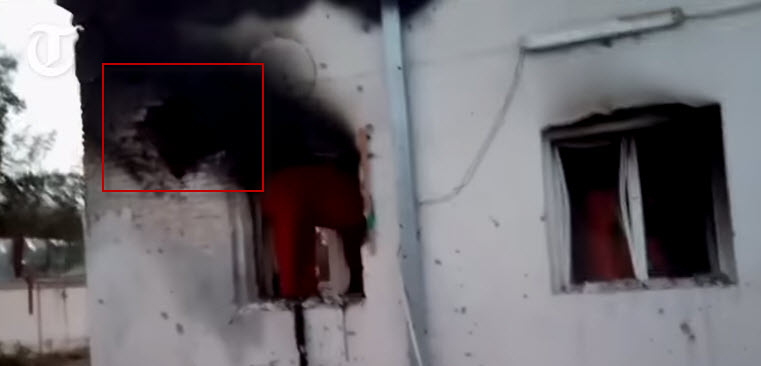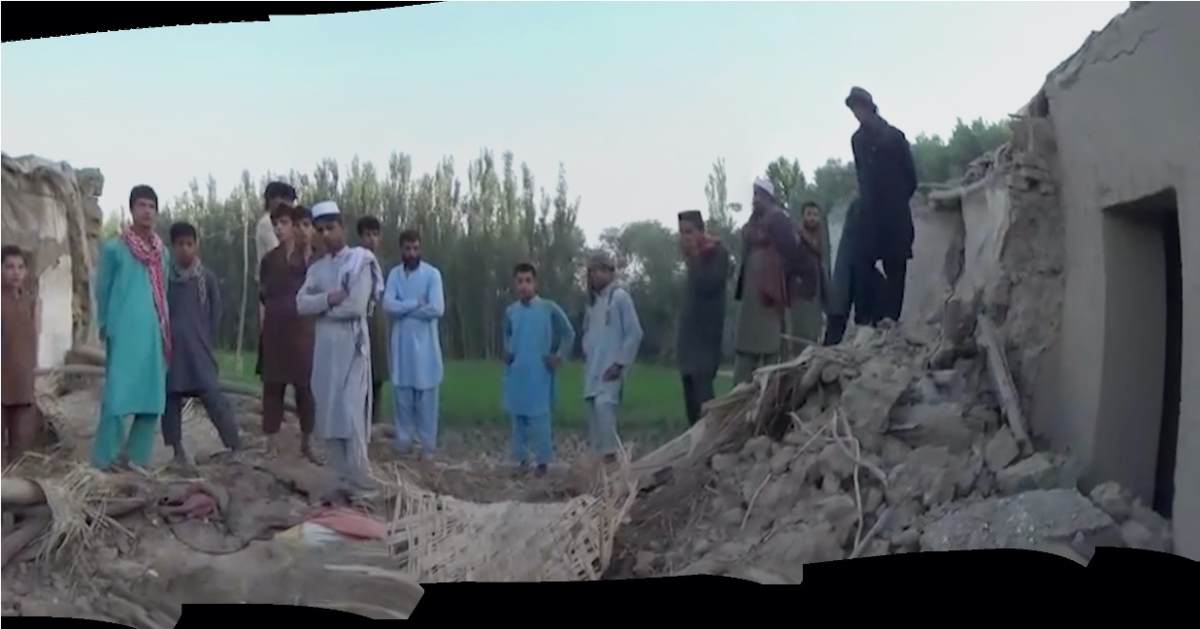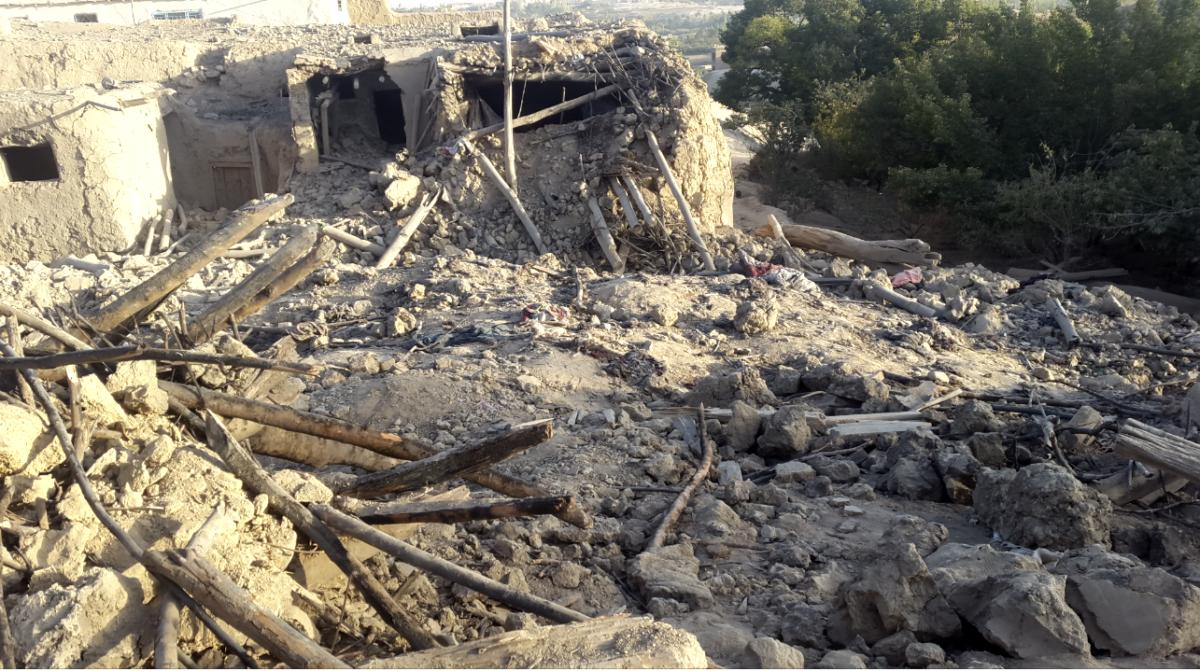U.S. Airstrike on Kunduz Hospital: An Open Source Overview
In the early hours of Saturday, October 3, the main building of the Kunduz Trauma Center, operated by Médecins Sans Frontières (MSF), was hit by a series of airstrikes that last for approximately an hour. By latest counts, 22 people, including multiple children, were killed by the attack carried out by United States/Coalition forces.
There is not a wealth of open source information available relating to this attack, but this article will attempt to gather the available information to corroborate the MSF account of the airstrike. The first part of this article will attempt to establish the type of weapon used in the attack from an evaluation of available open source information and witness testimonies. In the second part, a widely shared video from the Associated Press of the aftermath of the attack will be verified by geolocating the path of the cameraman through the video and the corroborating evidence of two additional photographs.
Weapon Type and Witness Accounts
The MSF account details how the aerial attack lasted for just over an hour:
From 2:08 AM until 3:15 AM local time today, MSF’s trauma hospital in Kunduz was hit by a series of aerial bombing raids at approximately 15 minute intervals.
U.S. officials have not yet confirmed the details of the attack, but the Washington Post received information from a reliable source an American AC-130 gunship was used:
WaPo NatSec Team gets new detail on apparent US airstrike on Doctors Without Borders, including use of AC-130 gunship http://t.co/kUwcsmxeuK
— Tim Craig (@timcraigpost) October 3, 2015
Update: The U.S. military has confirmed initial reports that an AC-130 gunship was responsible for the airstrike, but did not specify the variant used
On October 1st, Mustafa Kazema reported that the U.S. military did deploy one AC-130 to Kunduz in response to the Taliban takeover of the city:
US military has also sent one AC-130 and multiple CH-47s for transportation and AH-64s for air support to Kunduz. Not aware if UAVs deployed
— Mustafa Kazemi (@CombatJourno) October 1, 2015
Since the attack took place, many have speculated that the AC-130H Spectre model was used (see here, here, and here for examples); however, this does not seem to be the case. The United States retired the AC-130H Spectre gunship in May 2015 (see here and here), moving to newer models. It is more likely that a new model, such as the AC-130U Spooky gunship or the AC-130W Stinger II was responsible for the attack on the hospital and the resulting 22 civilian deaths. All three of these models are still in use, unlike the AC-130H.
This graphic from The Washington Post shows the various weapon systems on the AC-130U gunship, including a 105mm howitzer:
A 105mm howitzer and possibly a 40mm gun were likely used in the airstrike, judging by the patterns of damage. The two videos below show the attack pattern of the gunship, depicting events fairly close to the attack pattern described by MSF witnesses:
Additionally, some damage on the building’s exterior resembles the result of a 40mm gun; however,it may not be possible to conclusively determine this from only open source data.
The witness testimonies provided by the MSF reinforce this hypothesis. Witness testimonies attest that a single plane carried out the attack, and was heard circling above Kunduz:
“The bombs hit and then we heard the plane circle round,” said Heman Nagarathnam, MSF Head of Programmes in northern Afghanistan.
“There was a pause, and then more bombs hit. This happened again and again. When I made it out from the office, the main hospital building was engulfed in flames.
Afghan officials initially claimed that “helicopter gunships had returned fire from Taliban fighters hiding in the compound,” but there has been no evidence that a helicopter fired on the hospital. Telling the difference between a howitzer shell and a smart bomb may be difficult for an eye witness, but to mistake a helicopter for a single plane seems very unlikely.
Verifying Video Evidence
The morning after the bombing, one video was shown on nearly every international news organization. This video shows the devastation at the main building of the trauma center. We will verify this video by geolocating the path of the cameraman, along with juxtaposing the scenes from the video with additional photographs from immediately after the bombing and the following morning.
First, we must find the actual location of the trauma center in Kunduz. The facilities at the trauma center are spread throughout a large area in central Kunduz, with a central main building and numerous smaller buildings on the south grounds (some photos of these facilities can be found in this 2013 blog post). These smaller buildings were not hit directly by the airstrike, but the main building was devastated, indicating that the main building was likely specifically targeted by the American AC-130U.
The trauma center is located at coordinates 36.7185477, 68.8619614, in between the Kunduz Regional (Provincial) Hospital and Traffic Square, the city’s main square. If you search for this location on Wikimapia, it is labeled as the District Hospital of Kunduz—the trauma center likely took over operation of this hospital building in 2011.
The most recent Google Earth and Bing Maps satellite imagery for the site is outdated, as it does not show numerous constructed facilities to the south of the main building. The New York Times used imagery from Bing Maps (provided by DigitalGlobe), which is about a year old and still shows facilities under construction:
With TerraServer, we can find the latest satellite imagery for April 2015. In this image, we can see all of the constructed buildings to the south of the main facility. However, for the purposes of this article, the main building is the only structure of importance, so a snapshot of Bing map imagery will be referenced.
In the video, the cameraman starts off pointing his camera east, while located to the southwest of the main building:
In the screenshot below, the cameraman is facing the south side of the west part of the facility. The scene captured is in the same location as an image released by the MSF/AFP/Getty Images, while the building was still on fire in the early hours of October 3.
The cameraman then walks around the west part of the building. In this shot, he is facing south, as a vehicle drives by. Like with the white and yellow arrows in the previous images, the red arrow on the map indicates the cameraman’s point of view:
Turning the corner, the cameraman is now facing east, moving towards the north entrance to the facility. The perspective is now the same as a widely published photograph distributed by the MSF/AFP/Getty Images, showing the damaged main entrance to the facility. The area can be recognized by the central garden area at the front entrance, along with two bright green-painted structures along the walkways to the entrance. The overhanging roof of the entrance—which was been destroyed by the blast—is visible on the satellite imagery, most notably by the long shadow cast.
Finally, at the end of the clip, the cameraman walks northwards towards the entrance gate of the facility, before looking back at the scene. The path of the cameraman is indicated below, with the yellow arrow marking the point of view of the photographer in the night photograph.
The veracity of this video has not been widely questioned, as it was distributed by the Associated Press, and there are no red flags indicating that the video was misrepresented. However, it is still important to verify all available witness accounts and photographic/video evidence. To that end, everything checks out—this video was shot outside the Kunduz Trauma Center, and the depicted scene has been corroborated by credible witness accounts and two additional photographs released by the MSF/AFP/Getty Images.
Further open source investigation would be useful for determining if Taliban fighters were truly operating in the hospital, as Afghan officials have alleged. The MSF, which has shown no reason to be considered untrustworthy in its account of the airstrike, has steadfastly denied the Afghan claim, saying that on October 3, the “gates of the hospital were closed all night so no one that is not staff, a patient or a caretaker was inside the hospital when the bombing happened.”
Many thanks to Bellingcat contributors Veli-Pekka Kivimäki and Klement Anders for their invaluable assistance with this article
Update: Information added about AC-130W to first part of article, introducing the possibility that this AC-130 variant were used (not, as a commenter aptly pointed out, the AC-130J, as it will not be deployed until 2017). Additionally, confirmation from the U.S. military that an AC-130 gunship was used in the airstrike was added.










